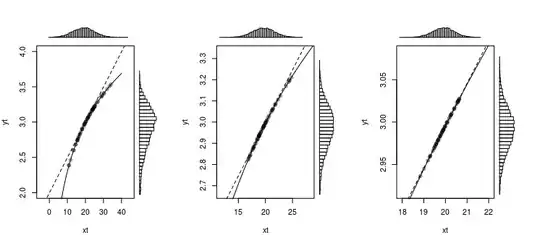I read the error propagation formula scanario said that, the connection between the variance of a random variable $x$ and $f(x)$ is $\frac{var(f(x))}{|\partial_xf(x)|_{x=\bar{x}}|^2}=var(x)$. While I'm confused in the prove of it in the process of Taylor series:
The proof of it states that, if we define the expected value of random variable $x$ and variance of it as follows: $$ \begin{aligned} \bar{x} &=\sum_{i=1}^{N} p_{i} x_{i} \\ (\Delta x)^{2} &=\sum_{i=1}^{N} p_{i}\left(x_{i}-\bar{x}\right)^{2} \\ &=\overline{x^{2}}-\bar{x}^{2} \end{aligned} $$ And the same for $f(x)$: $$ \begin{aligned} \overline{f(x)} &=\sum_{i=1}^{N} p_{i} f\left(x_{i}\right) \\ (\Delta f)^{2} &=\sum_{i=1}^{N} p_{i}\left(f\left(x_{i}\right)-\bar{f}\right)^{2} \end{aligned}\tag{1} $$ Then we can Taylor expanse it as: $$ \begin{aligned} f\left(x_{i}\right) &=\left.\sum_{n !}^{\infty} \frac{1}{n !}\left(x_{i}-\bar{x}\right)^{n} f^{(n)}(x)\right|_{x=\bar{x}} \\ &\approx f(\bar{x})+\left(x_{i}-\bar{x}\right) f^{(1)}(\bar{x}) \end{aligned}\tag{2} $$ ignoring the square and higher-order term. Then $\overline{f(x)}$ can be written as $$ \begin{aligned} \overline{f(x)} &\approx f(\bar{x})+\overline{\left(x_{i}-\bar{x}\right)} f^{(1)}(\bar{x}) \\ &=f(\bar{x}) \end{aligned}\tag{3} $$ Then replace eq (3) and (2) into (1), we can get $\frac{var(f(x))}{|\partial_xf(x)|_{x=\bar{x}}|^2}=var(x)$.
My question is, $x_i-\bar{x}$ is not always a small term!!! Why should we just discard it? Or, are there more formal references of this error propagation formula, because all I search online is some other kind of form.

